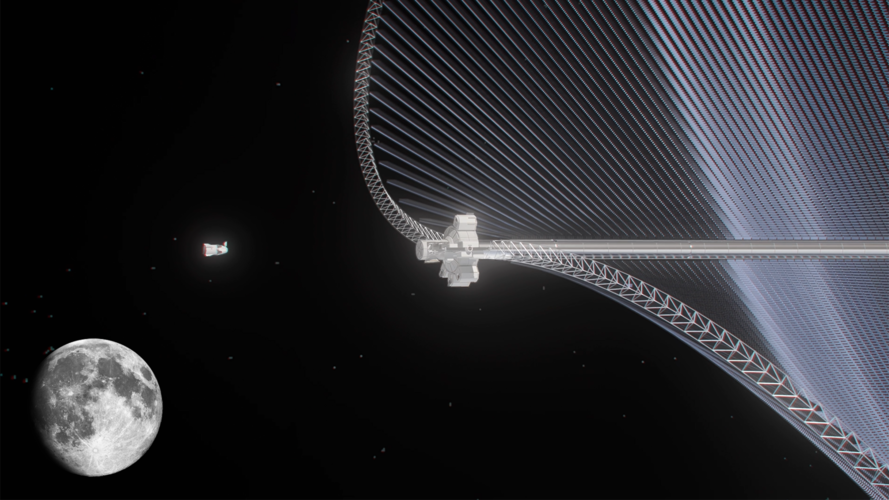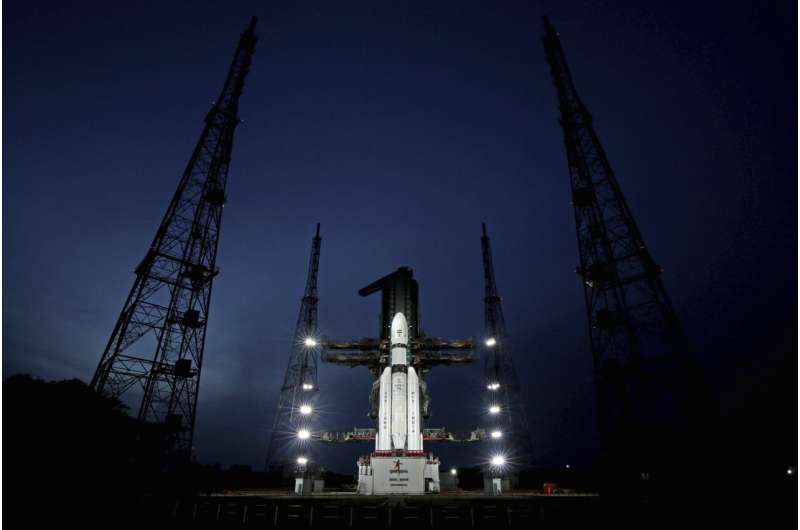
Copernical Team
Friday, 14 July 2023 06:45
ESA moves ahead with In-Orbit Servicing missions

Isn’t it strange that when satellites run out of fuel or a single component breaks down, we just discard them? ESA and European industry have joined forces to make sure that our satellites can live on.
Published in
News
Tagged under
Friday, 14 July 2023 07:00
Earth from Space: Ethiopian painting
 Image:
Reminiscent of an artist’s pallet, this striking false-colour image captured by the Copernicus Sentinel-2 mission features Lake Abbe in northeast Ethiopia.
Image:
Reminiscent of an artist’s pallet, this striking false-colour image captured by the Copernicus Sentinel-2 mission features Lake Abbe in northeast Ethiopia.
Published in
News
Tagged under
Friday, 14 July 2023 07:47
Lunar solar power satellite
 Image:
Lunar solar power satellite
Image:
Lunar solar power satellite
Published in
News
Tagged under
Friday, 14 July 2023 08:00
The sound of Aeolus will blow you away

After almost five years, ESA’s Aeolus wind satellite has completed its mission. Now, you can listen to the Life of Aeolus – an incredible wind orchestral piece that has been composed using data spanning Aeolus’ entire life in orbit around Earth.
Published in
News
Tagged under
Friday, 14 July 2023 05:05
India is set to launch a lander and rover to explore the moon's south pole

Published in
News
Tagged under
Friday, 14 July 2023 05:14
Astronomers identify the coldest star yet that emits radio waves
Sydney, Australia (SPX) Jul 14, 2023
 Astronomers at the University of Sydney have shown that a small, faint star is the coldest on record to produce emission at radio wavelength.
The 'ultracool brown dwarf' examined in the study is a ball of gas simmering at about 425 degrees centigrade - cooler than a typical campfire - without burning nuclear fuel.
By contrast, the surface temperature of the Sun, a nuclear inferno, is
Astronomers at the University of Sydney have shown that a small, faint star is the coldest on record to produce emission at radio wavelength.
The 'ultracool brown dwarf' examined in the study is a ball of gas simmering at about 425 degrees centigrade - cooler than a typical campfire - without burning nuclear fuel.
By contrast, the surface temperature of the Sun, a nuclear inferno, is
 Astronomers at the University of Sydney have shown that a small, faint star is the coldest on record to produce emission at radio wavelength.
The 'ultracool brown dwarf' examined in the study is a ball of gas simmering at about 425 degrees centigrade - cooler than a typical campfire - without burning nuclear fuel.
By contrast, the surface temperature of the Sun, a nuclear inferno, is
Astronomers at the University of Sydney have shown that a small, faint star is the coldest on record to produce emission at radio wavelength.
The 'ultracool brown dwarf' examined in the study is a ball of gas simmering at about 425 degrees centigrade - cooler than a typical campfire - without burning nuclear fuel.
By contrast, the surface temperature of the Sun, a nuclear inferno, is
Published in
News
Tagged under
Friday, 14 July 2023 05:14
Astronomers find answers to mysterious action of ghost stars in our Galaxy
Manchester UK (SPX) Jul 14, 2023
 A collaboration of scientists from The University of Manchester and the University of Hong Kong have found a source for the mysterious alignment of stars near the Galactic Centre.
The alignment of planetary nebulae was discovered ten years ago by a Manchester PhD student, Bryan Rees, but has remained unexplained.
New data obtained with the European Southern Observatory Very Large Tel
A collaboration of scientists from The University of Manchester and the University of Hong Kong have found a source for the mysterious alignment of stars near the Galactic Centre.
The alignment of planetary nebulae was discovered ten years ago by a Manchester PhD student, Bryan Rees, but has remained unexplained.
New data obtained with the European Southern Observatory Very Large Tel
 A collaboration of scientists from The University of Manchester and the University of Hong Kong have found a source for the mysterious alignment of stars near the Galactic Centre.
The alignment of planetary nebulae was discovered ten years ago by a Manchester PhD student, Bryan Rees, but has remained unexplained.
New data obtained with the European Southern Observatory Very Large Tel
A collaboration of scientists from The University of Manchester and the University of Hong Kong have found a source for the mysterious alignment of stars near the Galactic Centre.
The alignment of planetary nebulae was discovered ten years ago by a Manchester PhD student, Bryan Rees, but has remained unexplained.
New data obtained with the European Southern Observatory Very Large Tel
Published in
News
Tagged under
Friday, 14 July 2023 05:14
ESA ground facilities support ISRO's Chandrayaan-3 lunar mission
Paris (ESA) Jul 14, 2023
 The European Space Agency (ESA) is set to support the Chandrayaan-3 mission, launched by the Indian Space Research Organisation (ISRO). This Moon mission features a lunar lander and a rover, tasked to perform scientific operations on the lunar surface for a period of 14 days. To ensure the mission's success, ground stations worldwide, coordinated by ESA and NASA, are se
The European Space Agency (ESA) is set to support the Chandrayaan-3 mission, launched by the Indian Space Research Organisation (ISRO). This Moon mission features a lunar lander and a rover, tasked to perform scientific operations on the lunar surface for a period of 14 days. To ensure the mission's success, ground stations worldwide, coordinated by ESA and NASA, are se
 The European Space Agency (ESA) is set to support the Chandrayaan-3 mission, launched by the Indian Space Research Organisation (ISRO). This Moon mission features a lunar lander and a rover, tasked to perform scientific operations on the lunar surface for a period of 14 days. To ensure the mission's success, ground stations worldwide, coordinated by ESA and NASA, are se
The European Space Agency (ESA) is set to support the Chandrayaan-3 mission, launched by the Indian Space Research Organisation (ISRO). This Moon mission features a lunar lander and a rover, tasked to perform scientific operations on the lunar surface for a period of 14 days. To ensure the mission's success, ground stations worldwide, coordinated by ESA and NASA, are se
Published in
News
Tagged under
Friday, 14 July 2023 05:14
India to try again to land spacecraft on the moon
Washington DC (SPX) Jul 14, 2023
 After a disheartening 2019 moon landing failure, India's lunar exploration effort will resume Friday with the planned launch of Chandrayaan-3, a sophisticated, automated mission to touch down softly and demonstrate how its rover can navigate the surface.
Liftoff is planned for 5:05 p.m. EDT from the Satish Dhawan Space Station in Andhra province of Sriharikota just above Chennai on the sou
After a disheartening 2019 moon landing failure, India's lunar exploration effort will resume Friday with the planned launch of Chandrayaan-3, a sophisticated, automated mission to touch down softly and demonstrate how its rover can navigate the surface.
Liftoff is planned for 5:05 p.m. EDT from the Satish Dhawan Space Station in Andhra province of Sriharikota just above Chennai on the sou
 After a disheartening 2019 moon landing failure, India's lunar exploration effort will resume Friday with the planned launch of Chandrayaan-3, a sophisticated, automated mission to touch down softly and demonstrate how its rover can navigate the surface.
Liftoff is planned for 5:05 p.m. EDT from the Satish Dhawan Space Station in Andhra province of Sriharikota just above Chennai on the sou
After a disheartening 2019 moon landing failure, India's lunar exploration effort will resume Friday with the planned launch of Chandrayaan-3, a sophisticated, automated mission to touch down softly and demonstrate how its rover can navigate the surface.
Liftoff is planned for 5:05 p.m. EDT from the Satish Dhawan Space Station in Andhra province of Sriharikota just above Chennai on the sou
Published in
News
Tagged under
Friday, 14 July 2023 05:14
Sols 3887-3888: The Vastness
Pasadena CA (JPL) Jul 14, 2023
 Earth Planning Date: Wednesday, July 12, 2023 - A blue hue inches over the horizon illuminating a sea of rocks scattered across the landscape like the scales of a fish. Among the sea, alone in the vastness, a rover sleeps. The time is now 9:25, in a "time zone" defined for itself. The waking rover receives instructions from a tiny speck of light, far away and slowly creeping towards the other si
Earth Planning Date: Wednesday, July 12, 2023 - A blue hue inches over the horizon illuminating a sea of rocks scattered across the landscape like the scales of a fish. Among the sea, alone in the vastness, a rover sleeps. The time is now 9:25, in a "time zone" defined for itself. The waking rover receives instructions from a tiny speck of light, far away and slowly creeping towards the other si
 Earth Planning Date: Wednesday, July 12, 2023 - A blue hue inches over the horizon illuminating a sea of rocks scattered across the landscape like the scales of a fish. Among the sea, alone in the vastness, a rover sleeps. The time is now 9:25, in a "time zone" defined for itself. The waking rover receives instructions from a tiny speck of light, far away and slowly creeping towards the other si
Earth Planning Date: Wednesday, July 12, 2023 - A blue hue inches over the horizon illuminating a sea of rocks scattered across the landscape like the scales of a fish. Among the sea, alone in the vastness, a rover sleeps. The time is now 9:25, in a "time zone" defined for itself. The waking rover receives instructions from a tiny speck of light, far away and slowly creeping towards the other si
Published in
News
Tagged under
